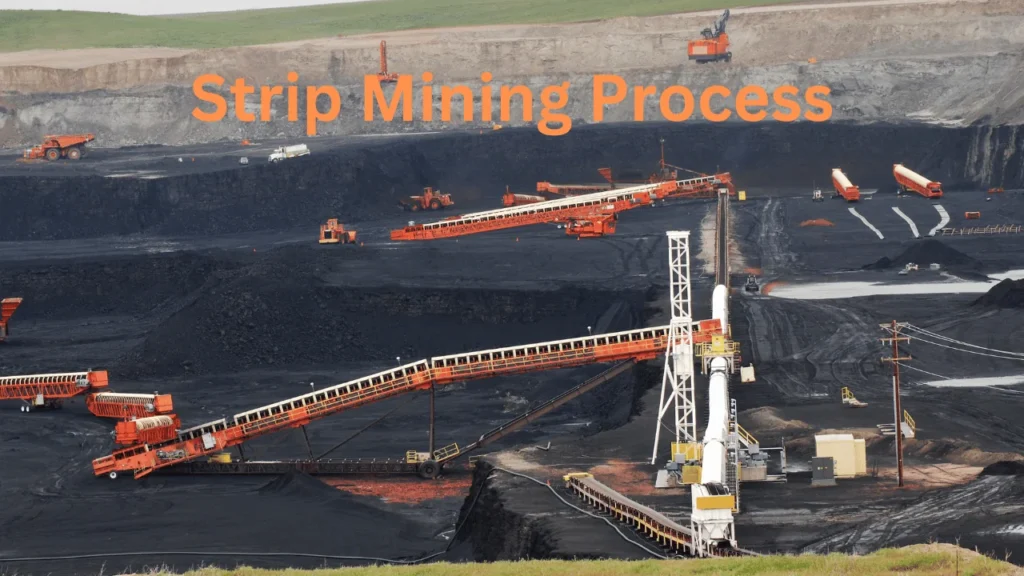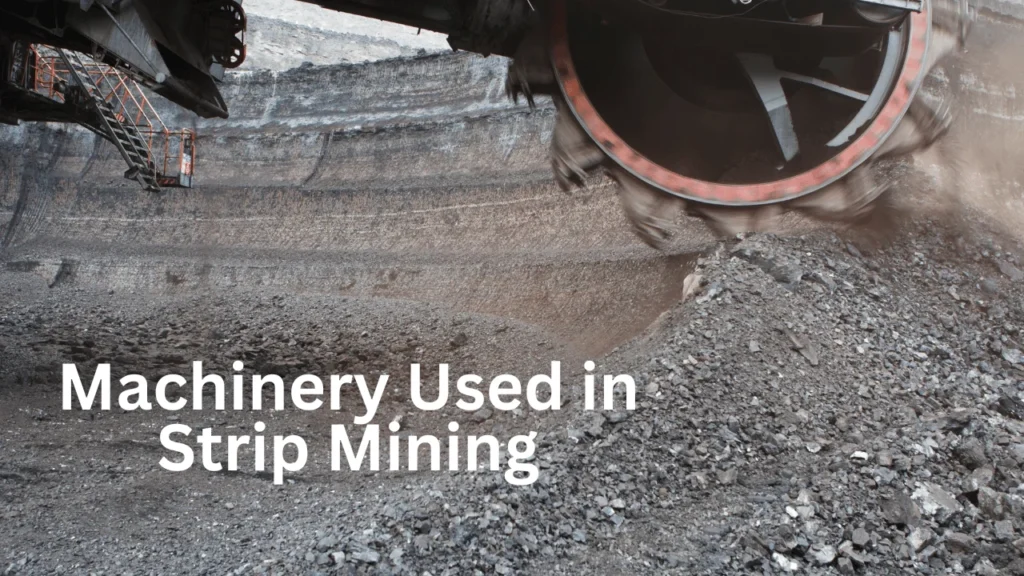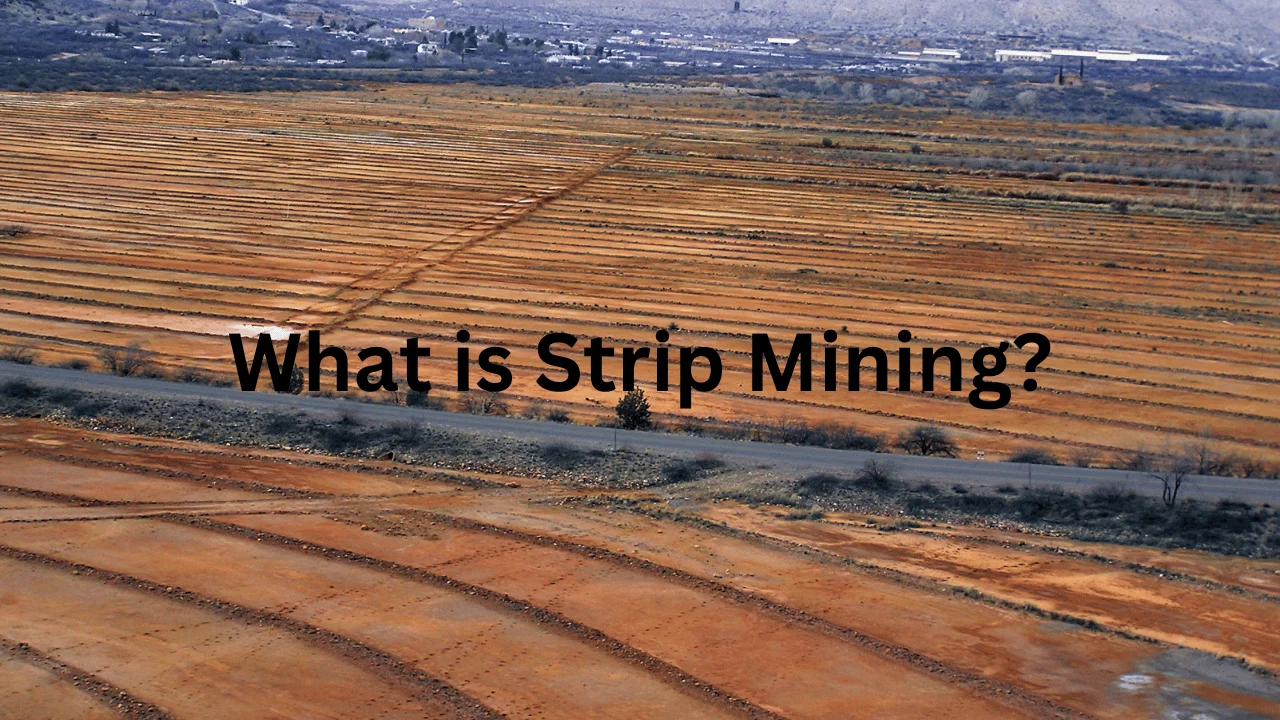For the most part, coal and other minerals located in horizontal beds close to the surface of the earth are extracted using strip mining, a type of surface mining. What is Strip Mining? In order to reach the mineral deposits below, this technique entails removing the top layer of soil and rock, which is called the overburden. Heavy equipment like draglines, bulldozers, and power shovels are used to remove the overburden after vegetation and topsoil have been cleared. The mineral seam is exposed and then extracted in layers or strips. Processing facilities are subsequently accessed by the mined material after it has been transported. Strip mining is a more cost-effective alternative to more disruptive underground mining techniques for extracting resources that are close to the surface. Deforestation, habitat loss, soil erosion, and the possibility of water contamination from contaminants’ runoff are some of the major environmental impacts of this technique. Replanting vegetation and restoring the landscape are examples of reclamation efforts that are essential for mitigating these effects, but they can be costly and challenging. Strip mining, in general, is an effective but controversial way to extract resources, so its long-term effects must be carefully considered.
Understanding Strip Mining
Definition of Strip Mining
Coal, limestone, and other near-surface rock minerals can be extracted using strip mining, which is also called surface mining. The process begins with excavating the area around the mineral deposit, which entails lifting the rock and dirt layers that cover it. Mineral seams that are either horizontal or slightly inclined and either too deep for open-pit mining or too shallow for underground mining are ideal candidates for this method.
Strip Mining Process

Efficient and effective mineral extraction is ensured by the detailed and multi-step strip mining process. The steps are as follows:
Site Preparation
The strip mining process begins with site preparation. Removal of vegetation and topsoil is a part of this process; the latter is usually retained for use in land reclamation projects down the road. In order to remove the overburden, it is necessary to clear the mining site so that it is accessible.
Overburden Removal
The soil and rock layers that sit atop the mineral deposit are called overburden and must be removed as a subsequent step. Power shovels, bulldozers, and draglines are used for this task. Spoil piles are the result of depositing the removed material in nearby areas.
Mineral Extraction
The extraction process starts after the overburden is excavated and the seam of minerals is revealed. This is usually mined in a sequential fashion, with each strip done in turn. Processing facilities refine and prepare the extracted material for use after transporting it.
Site Reclamation
The reclamation process begins after mineral extraction is complete. This entails replanting the area with vegetation, transferring the overburden back to the mined-out area, and replacing the stored topsoil. In order to lessen the ecological toll of the mining operations, it is necessary to return the landscape to its pre-mining condition.
Machinery Used in Strip Mining

To effectively remove the overburden and extract the minerals, strip mining uses a variety of heavy machinery. In strip mining, some of the most important machines are:
Draglines
When strip mining, draglines are among the biggest pieces of heavy gear utilised. To uncover the mineral seam, these machines drag a big bucket across the ground, removing the overburden in the process.
Bulldozers
To prepare the mining site for excavation, bulldozers remove vegetation and topsoil before moving overburden and spoil piles. Site preparation and reclamation are both facilitated by their powerful tracks and blades.
Power Shovels
The overburden is dug out and the mineral deposit is extracted using power shovels, which are also called electric mining shovels. The enormous buckets on these machines allow them to collect a lot of material with every pass.
Environmental Impact of Strip Mining
Strip mining is both an efficient and profitable mining method, but it has serious consequences for the environment. To effectively develop mitigation strategies, it is essential to have a thorough understanding of these impacts.
Deforestation and Habitat Destruction
Deforestation and habitat loss occur frequently as a result of strip mining because it clears vast areas of vegetation. Disruptions to ecosystems and the displacement of species are two potential outcomes for local wildlife.
Soil Erosion
Soil erosion becomes more likely when vegetation and topsoil are removed. Soil degradation and loss of fertile soil can occur when plants do not have roots to anchor the soil, making it more susceptible to erosion.
Water Pollution
Heavy metals and chemicals are among the contaminants that runoff from strip mines can transport to nearby bodies of water. As a result, aquatic ecosystems may suffer and drinking water supplies may be at risk of contamination.
Reclamation Challenges
The process of reclaiming land that has been strip-mined is arduous and expensive. It can take a long time to restore the original landscape and plant new vegetation; the success of reclamation efforts also varies greatly based on the local environment and the methods used.
Advantages and Disadvantages of Strip Mining
Economic Benefits
The financial gain is a major perk of strip mining. In comparison to other mining methods, this one can efficiently extract large quantities of minerals at a lower cost. Strip mining is a popular choice among mining companies due to its high productivity and low operational costs.
Job Creation
Numerous local jobs are generated by strip mining operations. From engineers and machine operators to environmental experts and secretaries, these positions cover a wide spectrum. Local economies can benefit from an influx of job opportunities.
Resource Accessibility
Strip mining allows for the extraction of minerals from areas that would be inaccessible or too expensive to mine using conventional methods. For commodities like coal, which are in great demand, this is of utmost importance.
Environmental Costs
Strip mining is beneficial to the economy, but it has a major negative impact on the environment. Landscape degradation, deforestation, soil erosion, and water contamination are major issues that require efficient management and restoration plans.
Long-term Impacts
Strip mining can have devastating effects in the long run, especially if cleanup attempts fail. Land degradation, biodiversity loss, and altered ecosystems can impact local communities and the environment for a long time.
Strip Mining vs. Underground Mining
Accessibility and Cost
When compared to underground mining, strip mining is typically more accessible and cheaper. There is less need for costly infrastructure and equipment needed for underground mining operations when minerals can be extracted directly from the surface after overburden is removed.
Safety Considerations
In comparison to underground mining, strip mining is generally thought to be safer. Strip mining is safer than other underground mining methods because cave-ins and gas explosions are not an issue.
Environmental Impact Comparison
Although there are environmental impacts from both underground and strip mining, the latter is often more aesthetically disturbing. Underground mining often causes subsidence and other problems but leaves less of a visible surface imprint than large-scale removal of vegetation and overburden.
Efficiency and Productivity
When compared to underground mining, strip mining is typically the more productive and efficient option. Overall production is increased and downtime is reduced when minerals can be continuously extracted from the surface without tunneling or other underground activities.
Regulations Governing Strip Mining
Environmental Protection Laws
Strip mining is regulated by various environmental protection laws in order to minimize its impact on the environment. Environmental impact assessments, mitigation strategies, and the successful reclamation of mined land are frequently mandated by these laws for mining companies.
Permitting and Compliance
Strip mining operations cannot commence until mining companies have obtained the necessary permits. Companies must follow certain environmental and safety standards in order to obtain these permits from regulatory agencies. All mining operations are subject to regular inspections and compliance checks to guarantee they meet all of these requirements.
Reclamation Requirements
Mining companies are obligated to return mined land to its original condition or a state that permits new uses as part of the reclamation process. Replanting vegetation and replacing topsoil are all part of this process, as is keeping an eye out for any long-term effects on the environment.
Community Engagement
In order to comply with regulations, mining companies are frequently compelled to interact with stakeholders and members of the local community. This involves informing the public about the mining project, responding to concerns, and making sure the locals reap the financial rewards of the mines.
Economic Impact of Strip Mining
Earnings from mining Generation
Mining companies and governments receive substantial revenue from strip mining. Mineral extraction and subsequent sales help fund a wide range of businesses and public works initiatives on a regional and national scale.
Employment Opportunities
There are a wide variety of jobs available in the strip mining industry, from low-level manual labor to high-level technical roles. Local economies can benefit from an influx of jobs, and workers and their families can enjoy an improved standard of living.
Infrastructure Development
Roads, power lines, and water distribution systems are examples of infrastructure that is frequently needed for strip mining operations. Better access to services and an improved quality of life are two ways in which local communities can reap the benefits of these improvements.
Challenges and Mitigation
Strip mining has both positive and negative effects on the economy. Among these are the aforementioned environmental impacts, possible disputes with nearby residents, and problems with land use. To tackle these challenges and guarantee that the economic advantages of strip mining are sustainable, effective management and mitigation strategies are essential.
Alternative Methods to Strip Mining
Open-Pit Mining
Among the many surface mining techniques, open-pit mining is characterized by the excavation of enormous open pits to reach mineral resources. Although it resembles strip mining, this technique is more suited to deeper and less uniformly shaped deposits.
Mountaintop Removal
The primary use of mountaintop removal, a type of strip mining, is the extraction of coal from mountainous areas. In this technique, the coal seams are exposed by removing the mountaintop. It is heavily regulated and has substantial environmental impacts, but it is very effective.
Contour Mining
When mining in hilly or mountainous terrain, contour mining is employed because the mineral seam follows the natural contours of the land. To access the mineral deposit, this technique cuts into the hillside following the contour lines. There are still environmental impacts, but it’s less disruptive than mountaintop removal.
In-Situ Mining
The process of in-situ mining, often called solution mining, entails bringing dissolved minerals to the surface using a pump. Deposits inaccessible by conventional mining techniques can be reached using this method, which causes less damage to the environment.
Frequently Asked Questions
What minerals are commonly extracted through strip mining?
Strip mining is commonly used to extract minerals such as coal, limestone, and other sedimentary rocks that are found close to the surface in horizontal or slightly inclined beds.
How does strip mining affect water quality?
Strip mining can affect water quality through runoff that carries contaminants such as heavy metals and chemicals into nearby water bodies, potentially polluting drinking water sources and harming aquatic ecosystems.
What equipment is used in strip mining?
Strip mining relies on heavy machinery such as draglines, bulldozers, and power shovels to remove the overburden and extract the mineral deposit.
How is land reclaimed after strip mining?
Land reclamation after strip mining involves returning the overburden to the mined-out area, replacing the stored topsoil, and replanting vegetation to restore the landscape to its original state or a condition that supports new uses.
What regulations govern strip mining operations?
Strip mining operations are governed by various environmental protection laws, permitting requirements, and reclamation standards designed to minimize environmental impacts and ensure the effective restoration of mined land.
Also Check: Thriveni Sainik Mining Private Limited: Overview
Conclusion
To sum up, what is strip mining? Strip mining is an economically beneficial and extremely efficient way to extract minerals. On the other hand, it creates major problems for the environment that need to be addressed through reclamation and regulation. Stakeholders can make well-informed decisions that minimize negative effects on the environment while maximizing positive ones by learning about the procedures, effects, and rules surrounding strip mining.

Brandy Stewart, an enchanting wordsmith and seasoned blogger, weaves compelling narratives that transport readers to uncharted territories. Infused with perceptive viewpoints and dynamic storytelling, Doris exhibits a command of language that enthralls both hearts and minds, leaving a lasting mark on the literary panorama.

